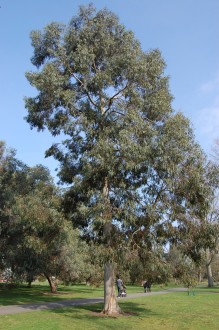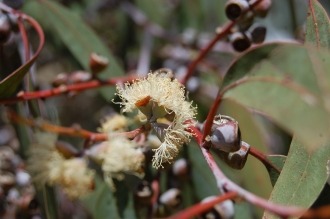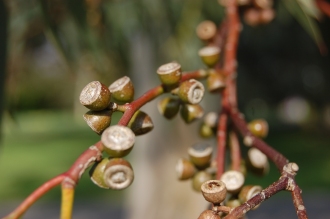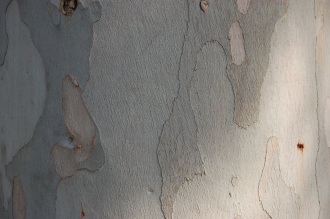Position: Full sun
Flowering period: Early summer
Soil: Moist, well drained, acidic
Eventual Height: 12m
Eventual Spread: 10m
Hardiness: 9a, 9b, 10a, 10b
Family: Myrtaceae
Eucalyptus perriniana is a small, fast growing, evergreen tree or mallee. This tree produces both adult and juvenile grey/ green leaves. The adult leaves are alternate, lanceolate, has a pointed tip and up to 12cm long and 2.5cm broad. The juvenile leaves are more silver in colour, orbicular or heart-shaped with the stem growing through the leaf and may have pink margins. The leaves have a pungent Eucalyptus odor. The bark of this tree is smooth, off-white/ grey/ green and flakes off the tree on an annual basis. Unusually for Eucalyptus this tree flowers on juvenile growth. The white flowers are insignificant and appear in clusters of three, up to 5mm long and usually appear in the leaf axils. Once fertilised these mature into cup shaped glaucous seed capsules.
Eucalyptus perriniana, commonly known as the Spinning Gum, the Round-Leafed Snow Gum, is native to south east Australia, including Tasmania. The juvenile, dead leave may remain on the stem, spinning on the stem.
The etymological root of the binomial name Eucalyptus is derived from the Greek eu ‘good‘ and kalyptos ’covered’ referring to the calyx which forms a lid over the flowers when in bud. We are not able to identify the root of Perriniana, reader comment would be welcome.
The landscape architect may find Eucalyptus perriniana useful as a small evergreen specimen tree. This tree is suitable for coppicing or pollarding, this encourages the growth of juvenile leaves. It is a suitable species to be used to stabilise soil and prevent erosion. Once established this tree is drought tolerant. It is suitable for maritime locations.
Ecologically, Eucalyptus perriniana flowers are attractive to bees.
Eucalyptus perriniana prefers moist, well-drained, sandy soils. It prefers a neutral to acidic pH of soil.
Eucalyptus perriniana requires little maintenance. Coppicing or pollarding should be carried out in late spring.










We find these in abundance in India. They are said to prevent soil erosion on hill slopes